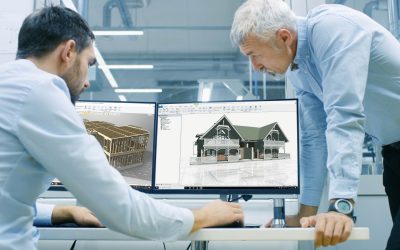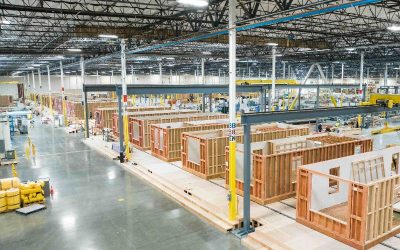DfMA: Why Manufacturing Is the Key to Viability — Blog 2: Why DfMA?
Design for manufacturing and assembly (DfMA) is a revolutionary approach to construction that is poised to reshape the economics of the global construction industry in the coming years.
Image: Puukoti Group
- Blog Post
- April 2023

- Pekka Moilanen
- Marketing Director
In the first blog of this series, I introduced DfMA and talked about how it involves designing and manufacturing all the components of a building in advance, in a factory, and then shipping them to the job site for assembly.
This approach completely overhauls the process of traditional construction. Even considering such a disruptive departure from the norm poses a big question: Is it worth it?
In this blog, I discuss the benefits of DfMA and the huge upside it offers to designers, builders, and owners once implemented at scale. You will see that design and manufacturing are key to unlocking the benefits of DfMA.
DfMA: Off-site Construction at Scale
I’ve written about the benefits of off-site construction, including reduced waste, increased quality, and accelerated construction schedules. But in the absence of large-scale DfMA, each of these benefits is only achievable on a per-project basis — and every project requires several key components to be present.
For example: For an off-site construction build to move forward, there must be an architect with the niche experience and building information modeling (BIM) tools to design the project, a contractor with specialized expertise and labor to build it, a factory to build the modular components, and an owner capable of financing and orchestrating the project.
While this is not a challenge in some markets, marshalling all these elements can be difficult for owners in others. The result is a lack of scale in off-site construction, which is clearly demonstrated by the fragmented growth of off-site construction around the world.
Under this approach, every project is effectively a one-off endeavor where specialized modules must be designed, built, and transported to the job site for assembly.
DfMA is about systematizing a means of design, manufacturing, and production that can be reproduced at scale, so owners don’t have to cobble together all these elements for each new build. But it requires a new way of thinking from the very beginning of a project.
A 2023 report published by the U.S. Department of Housing and Urban Development (HUD) explains that the distinction between off-site construction and DfMA is rooted in the design approach. Rather than designing a building with customized modules, the project team bases their design on an existing DfMA-friendly construction system or product.
By focusing on products and electing to use components that have already been designed and fabricated, owners, designers, and contractors can benefit from economies of scale. Essentially, all the benefits of off-site construction are compounded by DfMA.
Let’s discuss the biggest benefits of DfMA in further detail.
Increased Sustainability and Reduced Carbon Footprint
DfMA multiplies the environmental benefits of off-site construction, especially when it is paired with powerful BIM software.
Off-site construction is inherently more sustainable than traditional site-built approaches because it reduces waste and increases efficiency. The American Institute of Architects (AIA) also points out that off-site construction lends itself to more frequent use of recycled materials and fewer site visits and deliveries, reducing projects’ overall carbon footprint.
The combined benefits of BIM and DfMA enable environmentally conscious owners and project teams to take this sustainability a step further.
With the help of BIM software, architects can make deliberate choices about the prefabricated components selected for a given project in order to meet or exceed product sustainability goals.
The Forge office complex in London, UK, designed by the firm Bryden Wood, provides a recent high-profile example of the superior ecological outcomes that are possible when a combination of BIM and DfMA is employed. Bryden Wood’s use of BIM and DfMA allowed the complex’s two 10-story office buildings to generate 30% less embodied carbon than they would have if they had been produced using traditional design and construction methods.
Rather than designing buildings and then looking for sustainability interventions, architects can use BIM to design sustainability into projects from their inception.
Construction Benefits
DfMA improves upon the traditional construction process in several respects, starting with enhanced coordination and collaboration between the architect, general contractor (GC), and subcontractors.
Construction Dive describes how DfMA enhances coordination both vertically and horizontally across the project, beginning with the architect and GC. Rather than designing an entire building before putting drawings out for bid to contractors, designers of DfMA projects frequently begin co-designing the project with the GC and relevant subcontractors from the outset of the project.
Enhanced collaboration benefits all parties because architects can design a building that is “in line with how it will actually be built,” and the GC can contribute to the design from a “means and methods” standpoint, ensuring that the design is ultimately reflective of the building process to be used. Subcontractors also benefit from clarifying their scopes of work and responsibilities well in advance of commencing work.
DfMA can also improve the overall quality of construction projects. Projects can be designed with simplicity and reduced complexity in mind, which reduces the chance of errors in fabrication and assembly. Rather than using multiple wall panel models for a building, the building can be designed around a single panel design that is used throughout the project.
Time is always of the essence in construction, and DfMA enables faster design and building cycles, as well as accelerated schedules.
Financial Benefits
A 2019 report by McKinsey found that if all industry stakeholders could move toward a product-focused approach, the productivity benefits from prefabrication could save Europe and the U.S. $22 billion a year by 2030.
Taking a closer look, it’s clear that the financial benefits of DfMA are a function of the construction and sustainability benefits.
DfMA projects designed with simplicity and efficiency in mind require fewer unique parts and also result in reduced labor costs on the job site. Higher quality builds yield a reduced cost of ownership and can be designed to be incredibly energy efficient, saving owners costs for decades to come while maximizing sustainability.
Depending on how a project is financed, the accelerated construction schedule can result in financing cost savings for owners who can complete projects faster and with reduced risk of delays due to weather or other environmental challenges.
DfMA in the Years to Come
Stay tuned for my next blog, where I will discuss recent peaks and valleys in the growth of DfMA and how the industry is changing today.
DfMA is only in the early stages of overhauling the construction industry, and over the next few years we may begin to see the incredible potential of this construction method realized.
Related Stories
Best 3D construction software for professionals
Best 3D construction software for professionals 3D construction software has become a cornerstone of modern building projects, fundamentally transforming traditional construction practices. By enabling architects, engineers, and builders to create highly detailed,...
Leading construction design software for professionals
Leading construction design software for professionals In the ever-evolving construction industry, construction design software has become indispensable for streamlining workflows, enhancing accuracy, and improving collaboration. Among the available options, Vertex BD...
What is modular building design? – Unlock efficiency and precision
To fully unlock the potential of modular building design, it’s essential to utilize advanced tools that streamline the process from design to construction. While modular construction already offers significant advantages like faster timelines and cost savings, a tool like Vertex BD takes it further by integrating design and manufacturing into one seamless platform.




